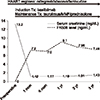1. Choi A, Scherzer R, Bacchetti P, Tien PC, Saag MS, Gibert CL, et al. Cystatin C, albuminuria, and 5-year all-cause mortality in HIV-infected persons. Am J Kidney Dis. 2010; 56:872–882.

2. Günthard HF, Aberg JA, Eron JJ, Hoy JF, Telenti A, Benson CA, et al. Antiretroviral treatment of adult HIV infection: 2014 recommendations of the International Antiviral Society-USA Panel. JAMA. 2014; 312:410–425.
3. Stock PG, Barin B, Murphy B, Hanto D, Diego JM, Light J, et al. Outcomes of kidney transplantation in HIV-infected recipients. N Engl J Med. 2010; 363:2004–2014.

4. Roland ME, Barin B, Carlson L, Frassetto LA, Terrault NA, Hirose R, et al. HIV-infected liver and kidney transplant recipients: 1- and 3-year outcomes. Am J Transplant. 2008; 8:355–365.

5. Mocroft A, Brettle R, Kirk O, Blaxhult A, Parkin JM, Antunes F, et al. Changes in the cause of death among HIV positive subjects across Europe: results from the EuroSIDA study. AIDS. 2002; 16:1663–1671.

6. Locke JE, Mehta S, Reed RD, MacLennan P, Massie A, Nellore A, et al. A national study of outcomes among HIV-infected kidney transplant recipients. J Am Soc Nephrol. 2015; 26:2222–2229.

7. Qiu J, Terasaki PI, Waki K, Cai J, Gjertson DW. HIV-positive renal recipients can achieve survival rates similar to those of HIV-negative patients. Transplantation. 2006; 81:1658–1661.

8. Roefs A, van der Ende M, IJzermans J, Weimar W, van Gelder T. Long-term survival after kidney transplantation in an HIV-positive patient. Clin Transplant. 2009; 23:278–281.

9. Roland ME, Barin B, Huprikar S, Murphy B, Hanto DW, Blumberg E, et al. Survival in HIV-positive transplant recipients compared with transplant candidates and with HIV-negative controls. AIDS. 2016; 30:435–444.

10. Solid organ transplantation in the HIV-infected patient. Am J Transplant. 2004; 4 Suppl 10:83–88.
11. Miró JM, Torre-Cisnero J, Moreno A, Tuset M, Quereda C, Laguno M, et al. GESIDA/GESITRA-SEIMC, PNS and ONT consensus document on solid organ transplant (SOT) in HIV-infected patients in Spain (March, 2005). Enferm Infecc Microbiol Clin. 2005; 23:353–362.

12. Bhagani S, Sweny P, Brook G. British HIV Association. Guidelines for kidney transplantation in patients with HIV disease. HIV Med. 2006; 7:133–139.

13. Trullas JC, Cofan F, Tuset M, Ricart MJ, Brunet M, Cervera C, et al. Renal transplantation in HIV-infected patients: 2010 update. Kidney Int. 2011; 79:825–842.

14. Norman SP, Kommareddi M, Kaul DR. Update on kidney transplantation in HIV-infected recipients. AIDS Rev. 2012; 14:195–207.
15. Panel de Expertos de Gesida. Plan Nacional sobre el Sida. AIDS Study Group/Spanish AIDS Plan consensus document on antiretroviral therapy in adults with human immunodeficiency virus infection (updated January 2010). Enferm Infecc Microbiol Clin. 2010; 28:362.e1–362.e91.
16. Thompson MA, Aberg JA, Cahn P, Montaner JS, Rizzardini G, Telenti A, et al. Antiretroviral treatment of adult HIV infection: 2010 recommendations of the International AIDS Society-USA panel. JAMA. 2010; 304:321–333.
17. Pulzer A, Seybold U, Schönermarck U, Stangl M, Habicht A, Bogner JR, et al. Calcineurin inhibitor dose-finding before kidney transplantation in HIV patients. Transpl Int. 2013; 26:254–258.

18. Karpas A, Lowdell M, Jacobson SK, Hill F. Inhibition of human immunodeficiency virus and growth of infected T cells by the immunosuppressive drugs cyclosporin A and FK 506. Proc Natl Acad Sci U S A. 1992; 89:8351–8355.

19. Franke EK, Luban J. Inhibition of HIV-1 replication by cyclosporine A or related compounds correlates with the ability to disrupt the Gag-cyclophilin A interaction. Virology. 1996; 222:279–282.












 PDF
PDF ePub
ePub Citation
Citation Print
Print




 XML Download
XML Download